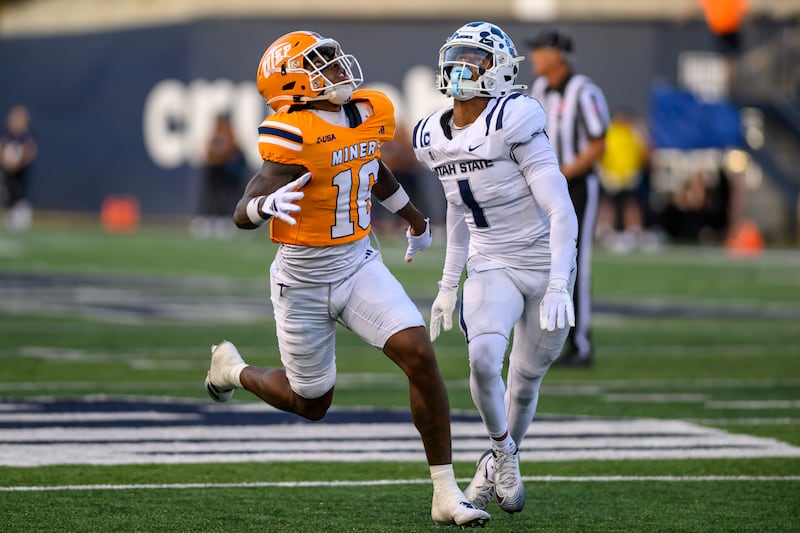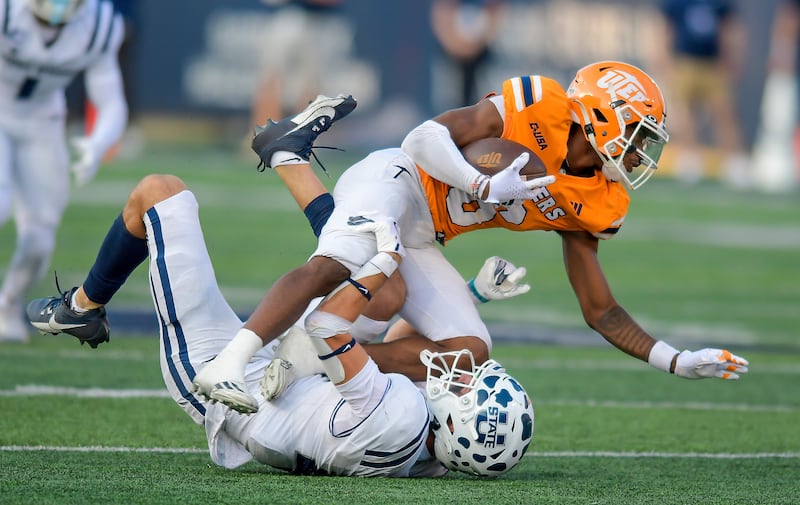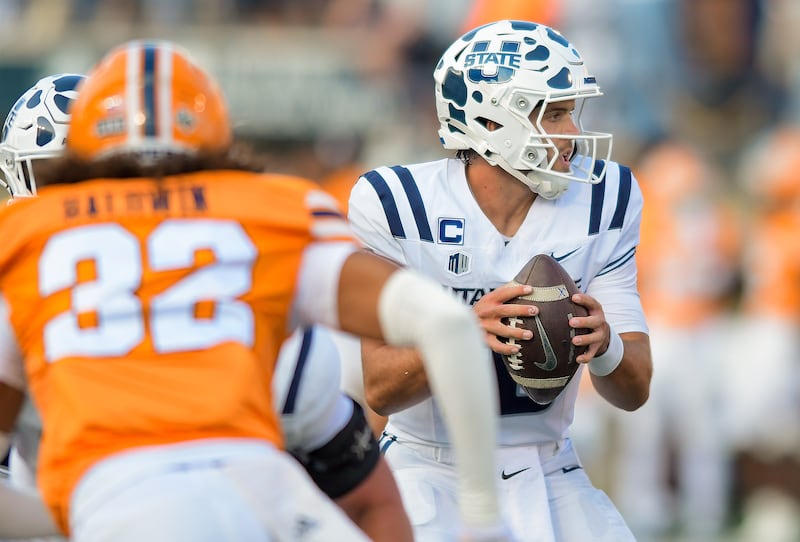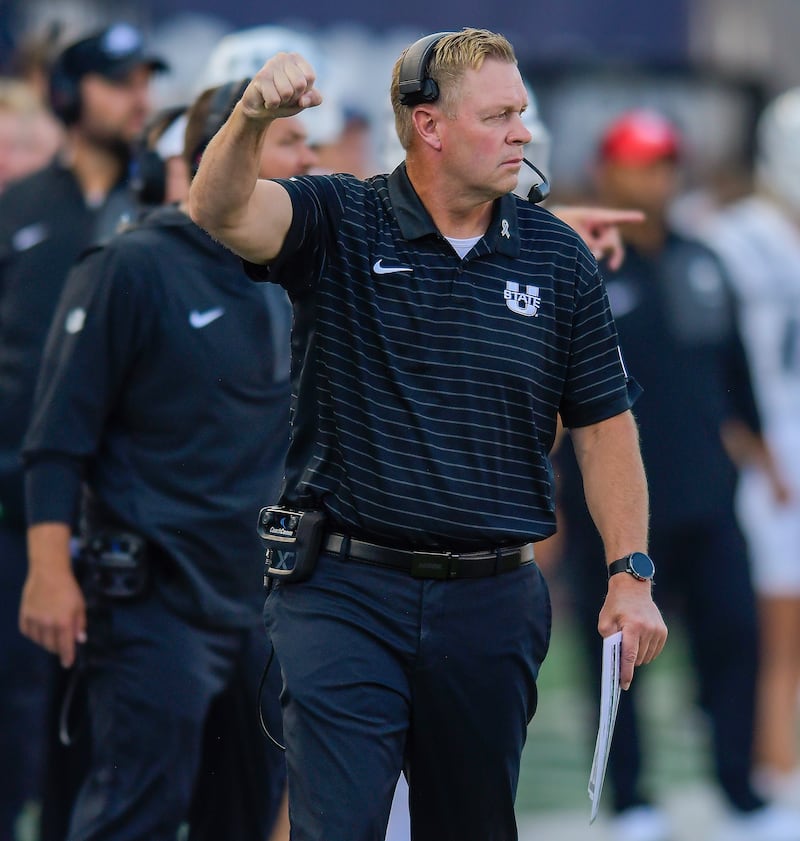Utah State football was pretty close to a complete mystery entering Saturday’s season opener against UTEP.
Utah State football was pretty close to a complete mystery entering Saturday’s season opener against UTEP.
There were a few knowns, like Bryson Barnes was QB1, Gabe Iniguez Jr., was the leader of the defensive line, and linebacker John Miller was primed for an even more productive season in 2025 than he had a year ago, but those knowns were significantly out-numbered by unknowns and question marks.
It was purposeful.
Bronco Mendenhall and his staff put a shroud over the program for various reasons including NIL, tampering and the transfer portal, and the result was no one really knew what kind of team the Aggies were going to be in 2025.
Realistically, no one knows now either, even after Utah State’s season opening win against UTEP.
Mendenhall said prior to the game that it could take weeks to really figure out who the 2025 Aggies are and that might be on the short end of the timeline.
“A year ago, it took through four games before we could even craft kind of schemes and strategies that really, truly matched that institution, that team, and then that put together a pretty nice stretch of success,” he said. “But it took some discovery, as much as you try to do it against yourself in fall camp, it’s difficult, especially at the front end. Doesn’t mean it’s impossible, but I would say, in general, and in college football, with the number of players moving, the number of coaches moving, most are finding it out as they go.”
That doesn’t mean that things weren’t learned from the Aggies’ victory over the Miners, though. It was a competitive football game with actual stakes and Utah State’s new approach was on display, even if not completely.
Here’s some of what could be gleaned from USU football’s season opener:
The transfers that the Aggies brought in are going to produce, not just provide depth

It isn’t a secret that when Mendenhall took over, he and his staff almost completely remade the Aggie roster. Seventy new players are on the team for the 2025 season alone, nearly 2/3 of the roster, and against UTEP 36 players or them made their debut.
Those 36 included true freshman, as well as holdovers from the previous era who had redshirted and not played, plus transfers from both the FBS and FCS ranks and junior college level.
By and large, the FBS and FCS transfers that the Aggies brought in, but even the junior college transfers in many cases, are of the plug-and-play variety. Meaning Utah State is going to rely on them for real meaningful production this season.
That was especially obvious on offense.
Between Miles Davis (BYU), Javen Jacobs (New Mexico), Braden Pegan (UCLA), Brady Boyd (Texas Tech) and Anthony Garcia (Arizona), seven of the nine Aggies who recorded at least a run or a reception were transfers this offseason, the only outliers being Barnes and tight end Broc Lane.
Against UTEP, Utah State doesn’t have an offense without transfers.
That held true on defense as well, although a little dramatically. Four of the Aggies’ top 10 tacklers Saturday were transfers, including leading tackler Noah Avinger (New Mexico), but also Brevin Hamblin (Utah Tech), Bryson Taylor (New Mexico) and Tyree Morris (Lafayette).
Only three players who played real minutes last season for the Aggies were also found in the top 10, namely Iniguez, Miller and Bronson Olevao Jr.
Even on special teams, it was transfers who made the greatest impact. Junior college transfer Tanner Rinker at placekicker, BYU transfer Landon Rehkow at punter, Davis at kick returner and Jacobs at punt returner.
Mendenhall said during the offseason that he didn’t promise anyone playing time, but the reality is that playing time was available to be had and the transfers who were brought in were brought in to see the field. Utah State clearly needs them to.
Singling out Avinger and Davis, Mendenhall said: “The quality of those two kids, they’re the exact type of young people that I want at Utah State. They’re bright, articulate, great leaders, excellent community members, good students, grateful to play college football and grateful to play it here. They’re great examples to those around them and having those two play the way they did couldn’t be more reflective of the direction I want the program to go in and with whom.”
Tackling might be a strength of this Utah State team, but at the very least it shouldn’t be a major weakness anymore

It has been a long time since defense was a strong suit of Utah State’s. You probably have to go back to the Gary Andersen era (part two) to find an Aggie team that skewed more towards defense than offense.
It was probably during the Andersen era that Aggie fans could last be picky about tackling. For years, Utah State has struggled to wrap up, to set the edge, to do the basics required for a solid defense.
No one should believe UTEP will have a vaunted offense or anything, but Utah State still showed considerable growth when it comes to the basics of good defense against the Miners.
It was most evident with the play of the secondary. Avinger, Hamblin, Taylor, Courage Ugo and Dylan Tucker all had at least one solo tackle, most more than one. Utah State defensive backs regularly made key stops on the outside on their own, stops that cut UTEP drives short and got the Aggie defense off the field, particularly during a second half when the USU offense couldn’t get much going at all.
It wasn’t just the secondary, though. USU linebackers Olevao Jr., Miller, Chris Joe and William Holmes all made notable plays, combing for four of the Aggies’ seven tackles for loss in the game.
Up front, Iniguez, Morris and Carson Tujague all made plays on the inside to get the Aggies off the field.
It might seem simple, but that simply hadn’t happened for Utah State for awhile. Not consistently at least, but it was consistently happening Saturday.
“We have a physical defense,” Mendenhall said. “They have tough football players. They have guys who like contact, to the point where our roster, man, it’s hard for us practice and our injury list is growing just as we practice against each other because they like contact. I think that showed throughout (the game). We’re fiercely conditioned. We also knew that this was an up-tempo (UTEP) team and that was going to be tested, and they I thought (my guys) handled that really well.
“(There were) nine different defensive linemen that you saw rotating through. I thought we managed that exceptionally well. Coach (Donte) Wilkins, coach (Nick) Howell maximized within the rules what we could do to do that, so we could play as fresh and as fast, but they like the chance to make contact, and is that fun as a defensive coach.”
Utah State needs playmakers to take some of the burden off Barnes

Not everything learned about the Aggies was sunshine and rainbows, however. It grew abundantly clear as the game progressed that the load on Barnes is a bit unmanageable.
The sixth-year quarterback did well in the game. From the outset he was calm and in command of the Aggie offense. Early on especially, Barnes was able to find receivers open, usually on the outside. And when he wasn’t, the threat of the pass was enough to open running lanes for himself or the running back duo of Davis and Jacobs.
As the game progressed, though, Davis and Jacobs grew more and more invisible. And receivers like Pegan and Body — frequent targets early — started to disappear.
For a good portion of the second half the Aggies’ offense devolved into Barnes rolling out of the pocket, surveying the field to see if he could find anyone open and when that didn’t work trying to run. Sometimes it worked. More often than not it didn’t.
Barnes’ dual-threat ability will be a boon for Utah State this season. He’s a proven runner and he looked better as a passer Saturday than arguably at any time in 2024.
He didn’t get enough support, however, from his skill position players. Utah State will need more from them going forward. More along the lines of Davis’ 58-yard touchdown run and less of the two yards up the gut for a minimal gain. More of Lane getting open downfield for a 50-plus yard reception and less Pegan, Boyd and Garcia being covered up too well for Barnes to do anything but try and make something out of nothing.
UTEP may be improved defensively this year. Head coach Scotty Walden seemed to think so.
“I’m disappointed with the outcome, but the process showed glimpses of being really good,” he said. “I don’t know what it is, but I’ve got a certain peace about this team. I truly believe that this team can be special. I really do. There are little things, like on the first drive, (Utah State) drove the ball down the field 60 yards and we held them to a field goal. Last year, that’s a touchdown. I’m just looking at progression from year one to year two, and I truly believe that we’ve made a lot of progression.”
But if USU is going to be competitive in 2025, in and out of Mountain West Conference play, it will need to give Barnes more help on offense.
Special teams has the potential to win multiple games for the Aggies

It has been awhile since special teams were a real difference making part of the game for Utah State. You may have to go back to the days of Savon Scarver and Dominik Eberle to find an Aggie special teams unit that actually won games for the USU in a meaningful and consistent way.
The potential is there for the current special team group to be that for the Aggies in 2025, though.
Rinker, for one, was excellent in his USU debut. He was flawless and the best he’d ever been too. He was 2-for-2 on field goal attempts which included a career-long 49-yard field goal which just so happened to be the first field he attempted as an Aggie.
After and up-and-down season last year at placekicker, Rinker’s immediate steadiness was refreshing.
Rehkow, meanwhile, punted a career high seven times for an average of 47.4 yards, including a career long punt of 54 yards. He also had a career-high three punts downed inside the 20-yard line. It is an extremely small sample size, but for comparison — former USU standout punter Stephen Kotsanlee had a career average 42.6 yards per punt, which is the fourth-best average in school history.
Rehkow may not sustain what he did against UTEP, but he definitely looked the part of a real weapon out there.
Then there was Jacobs, who tied his career high with five punt returns for a career-high 22 yards. Having a good punt returner is a game-changer and Jacobs has the potential to be just that.
All that before even mentioning the successful two-point conversion Utah State had, which, per Mendenhall, altered the course of the game Saturday.
“Normally as you begin, sometimes special teams is a little loose, but I thought we did a really nice job there,“ he said. ”I thought our two-point conversion out of our swinging gate, also a special teams play, was a critical play for the margin and helped us manage the game down the end.”
There will be a lot more to learn about Utah State football this season. Especially given looming games against Texas A&M and Vanderbilt await before MWC play kicks in in earnest in Oct.
But we at least know a little bit more than we did before the Aggies played the Miners.
Source: Utah News
